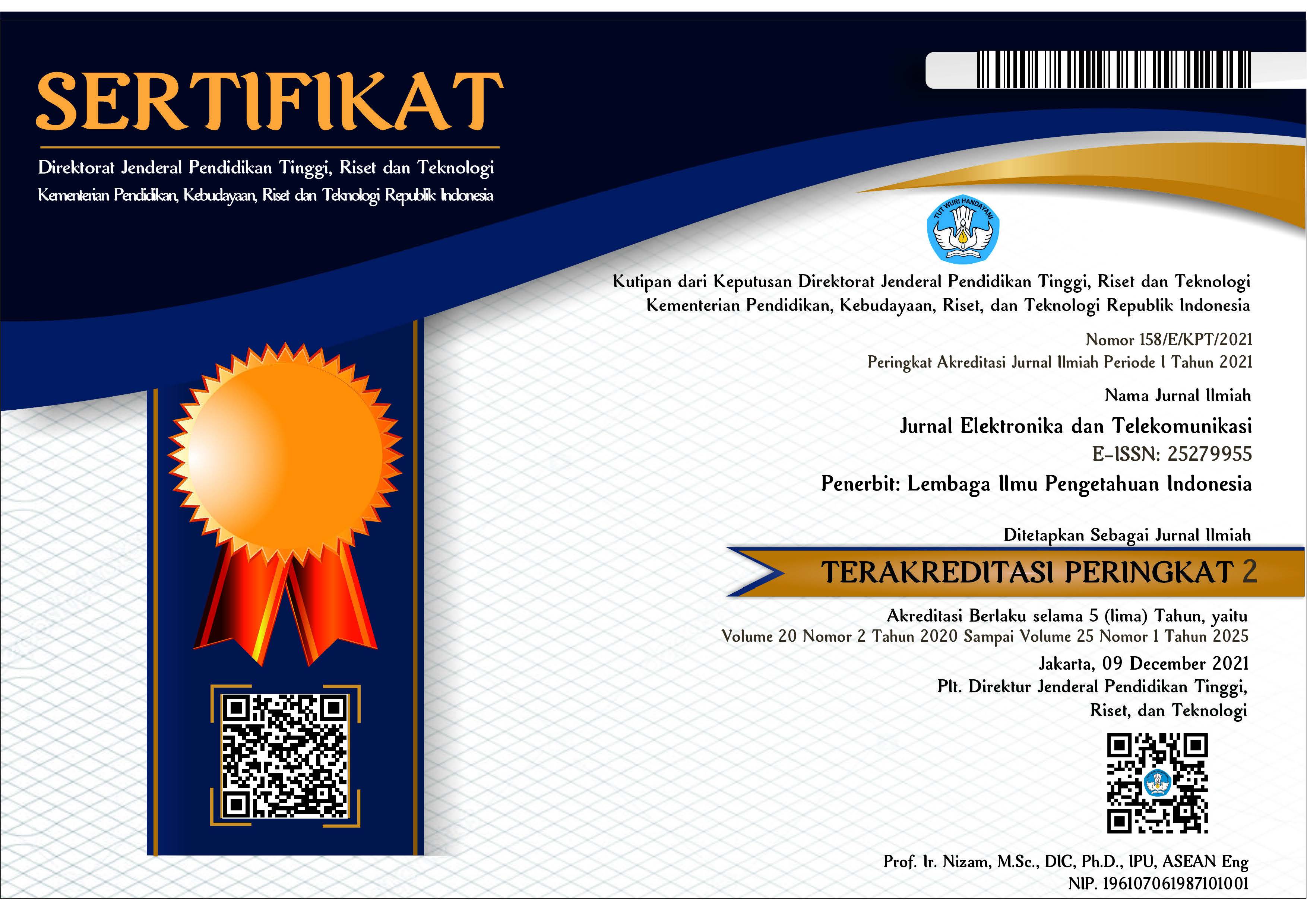Computational Analysis of Electrical Impedance Spectroscopy for Margin Tissue Detection in Laparoscopic Liver Resection
Abstract
Margin tissue detection during intraoperative laparoscopic liver resection (LLR) is required to prevent tumor recurrence and reduce the likelihood of further surgery. This study proposes an electrical impedance spectroscopy (EIS) method for margin tissue detection in LLR to determine the boundary interface of normal and cancerous tissue. The proposed method of this study has three objectives: (1) designing the electrode array configuration to collect multiple EIS impedance measurements, (2) implementing the Feedforward Neural Network (FNN) to classify the orientation of margin tissue relative to the electrode array by using time-difference impedance indexes, and (4) governing the inflection point method based on impedance indexes to detect the margin tissue location. The proposed method is evaluated by a 3D numerical simulation of liver tissue composed of cancerous lumps with Iac = 1 mA alternating injection current at frequencies: lf = 1 kHz and hf = 100 kHz. The electrode array is composed of 16 electrode pairs each for injection current and voltage measurements. The variation of margin tissue orientation relative to the electrode array direction was considered to occur in unidirectional, perpendicular, and diagonal direction with noise variations (Signal-to-Noise-Ratio: 50 to 90 dB). The FNN trained on 2,400 data points achieves True Positive Rate (TPR) value as 90.2%, 99.4%, and 96.6% for diagonal, perpendicular, and unidirectional respectively in margin tissue orientation classification, while the inflection point method detects margin tissue location with 75% location at the unidirectional orientation (y-axis).
Keywords
References
H. Rumgay et al., “Global burden of primary liver cancer in 2020 and predictions to 2040,” J. Hepatol., vol. 77, no. 6, pp. 1598–1606, Dec. 2022, doi: 10.1016/J.JHEP.2022.08.021.
J. H. Oh and D. W. Jun, “The latest global burden of liver cancer: a past and present threat,” Clin. Mol. Hepatol., vol. 29, no. 2, p. 355, Apr. 2023, doi: 10.3350/CMH.2023.0070.
Y. Le Linn et al., “Systematic review and meta-analysis of difficulty scoring systems for laparoscopic and robotic liver resections,” J. Hepatobiliary. Pancreat. Sci., vol. 30, no. 1, pp. 36–59, Jan. 2023, doi: 10.1002/JHBP.1211.
C. Jia, H. Li, N. Wen, J. Chen, Y. Wei, and B. Li, “Laparoscopic liver resection: a review of current indications and surgical techniques,” Hepatobiliary Surg. Nutr., vol. 7, no. 4, p. 277, Aug. 2018, doi: 10.21037/HBSN.2018.03.01.
H. Tugal, B. Gautier, B. Tang, G. Nabi, and M. S. Erden, “Hand-impedance measurements with robots during laparoscopy training,” Rob. Auton. Syst., vol. 154, p. 104130, Aug. 2022, doi: 10.1016/J.ROBOT.2022.104130.
K. Parashar et al., “Imaging technologies for presurgical margin assessment of basal cell carcinoma,” J. Am. Acad. Dermatol., vol. 88, no. 1, pp. 144–151, Jan. 2023, doi: 10.1016/J.JAAD.2021.11.010.
A. Sambri et al., “Margin assessment in soft tissue sarcomas: review of the literature,” Cancers (Basel)., vol. 13, no. 7, Apr. 2021, doi: 10.3390/CANCERS13071687.
T. A. Moo et al., “Impact of margin assessment method on positive margin rate and total volume excised,” Ann. Surg. Oncol., vol. 21, no. 1, pp. 86–92, Jan. 2014, doi: 10.1245/S10434-013-3257-2/TABLES/3.
S. G. Brouwer de Koning, A. W. M. A. Schaeffers, W. Schats, M. W. M. van den Brekel, T. J. M. Ruers, and M. B. Karakullukcu, “Assessment of the deep resection margin during oral cancer surgery: a systematic review,” Eur. J. Surg. Oncol., vol. 47, no. 9, pp. 2220–2232, 2021, doi: 10.1016/j.ejso.2021.04.016.
J. olde Heuvel et al., “State-of-the-art intraoperative imaging technologies for prostate margin assessment: a systematic review,” Eur. Urol. Focus, vol. 7, no. 4, pp. 733–741, 2021, doi: 10.1016/j.euf.2020.02.004.
R. J. Halter and Y. J. Kim, “Toward microendoscopic electrical impedance tomography for intraoperative surgical margin assessment,” IEEE Trans. Biomed. Eng., vol. 61, no. 11, pp. 2779–2786, 2014, doi: 10.1109/TBME.2014.2329461 WE - Science Citation Index Expanded (SCI-EXPANDED).
A. Mahara, S. Khan, E. K. Murphy, A. R. Schned, E. S. Hyams, and R. J. Halter, “3D microendoscopic electrical impedance tomography for margin assessment during robot-assisted laparoscopic prostatectomy,” IEEE Trans. Med. Imaging, vol. 34, no. 7, pp. 1590–1601, 2015, doi: 10.1109/TMI.2015.2407833.
E. K. Murphy et al., “Comparative study of separation between ex vivo prostatic malignant and benign tissue using electrical impedance spectroscopy and electrical impedance tomography,” Physiol. Meas., vol. 38, no. 6, p. 1242, May 2017, doi: 10.1088/1361-6579/AA660E.
Z. Cheng, D. Dall’alba, P. Fiorini, and T. R. Savarimuthu, “Robot-assisted electrical impedance scanning system for 2d electrical impedance tomography tissue inspection,” Proc. Annu. Int. Conf. IEEE Eng. Med. Biol. Soc. EMBS, no. February 2022, pp. 3729–3733, 2021, doi: 10.1109/EMBC46164.2021.9629590.
A. Doussan, E. Murphy, and R. Halter, “Towards intraoperative surgical margin assessment: validation of an electrical impedance-based probe with ex vivo bovine tissue,” in Proc. SPIE 9414, Med. Imaging 2015 Comput. Diagnosis, 2015, p. 94141C. doi: https://doi.org/10.1117/12.2082920.
K. A. Ibrahim, M. R. Baidillah, R. Wicaksono, and M. Takei, “Skin layer classification by feedforward neural network in bioelectrical impedance spectroscopy,” J Electr Bioimp, vol. 14, pp. 19–31, 2023, doi: https://doi.org/10.2478/joeb-2023-0004.
M. Morin et al., “Skin hydration dynamics investigated by electrical impedance techniques in vivo and in vitro,” Sci. Rep., vol. 10, no. 1, 2020, doi: 10.1038/s41598-020-73684-y WE - Science Citation Index Expanded (SCI-EXPANDED).
S. Ollmar and S. Grant, “Nevisense: improving the accuracy of diagnosing melanoma,” Melanoma Manag., vol. 3, no. 2, pp. 93–96, 2016, doi: 10.2217/mmt-2015-0004.
I. N. Rifai, M. R. Baidillah, R. Wicaksono, S. Akita, and M. Takei, “Sodium concentration imaging in dermis layer by square-wave open electrical impedance tomography ( sw- o eit ) with spatial voltage thresholding ( svt ),” Biomed. Phys. Eng. Express, vol. 9, p. 045013, 2023, doi: 10.1088/2057-1976/acd4c6.
B. Tsai, H. Xue, E. Birgersson, S. Ollmar, and U. Birgersson, “Dielectrical properties of living epidermis and dermis in the frequency range from 1 khz to 1 mhz,” J. Electr. Bioimpedance, vol. 10, no. 1, pp. 14–23, Jan. 2019, doi: 10.2478/joeb-2019-0003.
D. Andreuccetti, R. Fossi, and C. Petrucci, “An internet resource for the calculation of the dielectric properties of body tissues in the frequency range 10 hz - 100 ghz,” Florence (Italy), 1997. [Online]. Available: http://niremf.ifac.cnr.it/tissprop/
D. Haemmerich, D. J. Schutt, A. W. Wright, J. G. Webster, and D. M. Mahvi, “Electrical conductivity measurement of excised human metastatic liver tumours before and after thermal ablation,” Physiol. Meas., vol. 30, no. 5, p. 459, Apr. 2009, doi: 10.1088/0967-3334/30/5/003.
H. Wang et al., “Dielectric properties of human liver from 10hz to 100mhz: normal liver, hepatocellular carcinoma, hepatic fibrosis and liver hemangioma,” Biomed. Mater. Eng., vol. 24, no. 6, pp. 2725–2732, Jan. 2014, doi: 10.3233/BME-141090.
M. Rauseo et al., “Electrical impedance tomography during abdominal laparoscopic surgery: a physiological pilot study,” J. Clin. Med. 2023, Vol. 12, Page 7467, vol. 12, no. 23, p. 7467, Dec. 2023, doi: 10.3390/JCM12237467.
A. Zifan, P. Liatsis, and H. Almarzouqi, “Realistic forward and inverse model mesh generation for rapid three-dimensional thoracic electrical impedance imaging,” Comput. Biol. Med., vol. 107, pp. 97–108, Apr. 2019, doi: 10.1016/j.compbiomed.2019.02.007.
A. Adler and W. R. B. Lionheart, “Uses and abuses of eidors: an extensible software base for eit,” Physiol. Meas., vol. 27, no. 5, pp. S25–S42, May 2006, doi: 10.1088/0967-3334/27/5/S03.
M. R. Baidillah, S. Member, A.-A. S. Iman, Y. Sun, and M. Takei, “Electrical impedance spectro-tomography based on dielectric relaxation model,” IEEE Sens. J., vol. 17, no. 24, pp. 8251–8262, 2017, doi: 10.1109/JSEN.2017.2710146.
U. Anushree, S. Shetty, R. Kumar, and S. Bharati, “Adjunctive diagnostic methods for skin cancer detection: a review of electrical impedance-based techniques.,” Bioelectromagnetics, vol. 43, no. 3, pp. 193–210, 2022, doi: 10.1002/bem.22396.
H. J. Jeong, K. Kim, H. W. Kim, and Y. Park, “Classification between normal and cancerous human urothelial cells by using micro-dimensional electrochemical impedance spectroscopy combined with machine learning,” Sensors 2022, Vol. 22, Page 7969, vol. 22, no. 20, p. 7969, Oct. 2022, doi: 10.3390/S22207969.
P. A. Sejati, B. Sun, P. N. Darma, T. Shirai, K. Narita, and M. Takei, “Multinode electrical impedance tomography (mneit) throughout whole-body electrical muscle stimulation (wbems),” IEEE Trans. Instrum. Meas., vol. 72, 2023, doi: 10.1109/TIM.2023.3282295.
S. Huclova, D. Erni, and J. Fröhlich, “Modelling and validation of dielectric properties of human skin in the mhz region focusing on skin layer morphology and material composition,” J. Phys. D. Appl. Phys., vol. 45, no. 2, 2012, doi: 10.1088/0022-3727/45/2/025301.
S. Wang, J. Zhang, O. Gharbi, V. Vivier, and M. E. Orazem, “Electrochemical impedance spectroscopy,” Nat. Rev. Methods Prim., vol. 1, no. 41, p. 21, 2021, doi: 10.1038/s43586-021- 00039-w.
Article Metrics
Metrics powered by PLOS ALM
Refbacks
- There are currently no refbacks.
Copyright (c) 2024 National Research and Innovation Agency

This work is licensed under a Creative Commons Attribution-NonCommercial-ShareAlike 4.0 International License.























